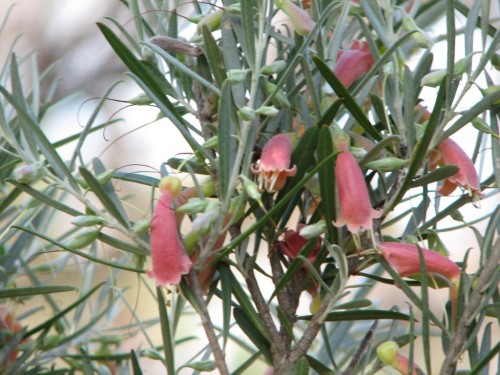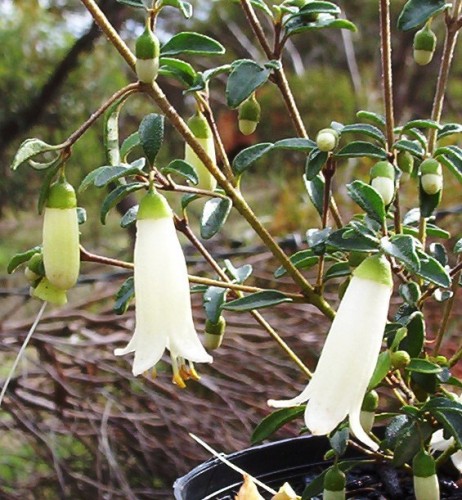Eremophila youngii
Eremophila youngii is one of my favourite flowering shrubs. My two plants are more than 15 years old, and very rarely are there no flowers. The Honey Eaters are having a feast at the moment and they tend to wreck the flowers in their search for nectar.
This shrub grows from 1-3m tall x .6-2m wide. It is a desert plant which has proved to be very hardy so long as it has good drainage and plenty of sunshine. It is hardy to frost and takes pruning well. It does very well in the highly alkaline soils and dry conditions here.
Here it is the last week of the middle of winter and yet many of the plants in the garden are showing flower buds and some are beginning to flower. From now on we need to be out and about with the camera to begin meeting my photographic aims this year.
Correa pulchella (White Flowered form)
This delightful Correa is probably the one that is called Kangaroo Island form. It is the Correa referred to in a previous post. Click here to read the information.
Propagating Acacias (Wattles)
Acacias are generally propagated from seed. Seed can be bought from native seed merchants and it stores well if you collect your own. I have lost some seed to weavils which disgusted me when I opened the bag of seed to find piles of ‘crumbs’ and some very well fed weavils.
Acacia seed has a very hard seed coat. I found it easier to use nail clippers to nick the side of the seed. This needs some dexterity to hold the seed between the fingers of one hand in such a position that the nippers of the nail clippers can actually get at the side of the seed!
However I have had 100% germination from seed that was actually large enough to do this.
Smaller seed I find easiest to abraid gently between two pieces of sand paper. Place one piece of sand paper on a board, the seed on that and use the other piece of sand paper, rough side against the seeds and twist the sand paper back and forth 3 0r 4 times. The seed casing can be seen to be thinner. I have found that too much pressure wrecks the seed like a grinding stone.
Seed is sown and covered to about the depth of the seed. I also use a thin layer of small washed gravel on top of this to prevent the seed from being washed out and to act as a mulch. Seed is best sown in autumn or spring. I had good germination in June this year but was actually saved by the fact that we had no rain.
Some Acacias can be propagated from cuttings. Firm new seasons growth is used.
Growing Acacias (Wattles)
Acacia is the largest genus in Australia with over 700 named species. They make excellent garden plants and it is possible to have at least one flowering through out the year if selected carefully for the growing conditions.
The leaves are not true leaves and are known as phyllodes. Many Acacias have very prickly or sharp pointed phyllodes, a fact that needs consideration when choosing species to grow. A prickly plant, regardless of the beauty of the plant in flower, is a pain (literally) if planted where one opens the door of the car and has to brush past it.
However to control foot traffic and for security, these have their uses. Small birds also appreciate the security of these prickly plants for nesting sites.
All Acacias are useful for erosion control. They respond well to pruning after flowering and this can extend the life of the plant. Wattles are very fast growing and can flower in the second year after germination.
The main pests are borers. These can be controlled by manually probing the hole with a piece of wirer or using a weak insecticide squirted into the hole. Some plants have galls and these are hard to control.
Research has shown that some species are sensitive to phosphorus in the soil and there is a need to take care with fertilisers. As a general rule a slow release fertiliser suitable for Native plants is safest. Symptoms of sensitivity are browning of the edges and dropping of the older leaves.
A good source of pollen, Wattles are popular with apiarist. The seeds are also an important source of food for birds. The seeds of Acacia calamifolia are part of the diet of the endangered Mallee Fowl. Some other species of Wattle are part of the Bush Tucker industry, particularly Acacia victoriae. As the seeds of some species are actually toxic, one needs to be sure of the identity of a species!
Acacia celastrifolia
This is a most beautiful Wattle and I can see why someone planted it at Wittunga. It flowers from July to October and the flowers were not quite fully open when we were there.
A Western Australian species, it grows 2-4m high by 1.5-2m wide. It needs well drained soil and partial to full sun. This Acacia prefers shelter from strong winds and is suitable for sheltered coastal planting. Light pruning is recommended.


